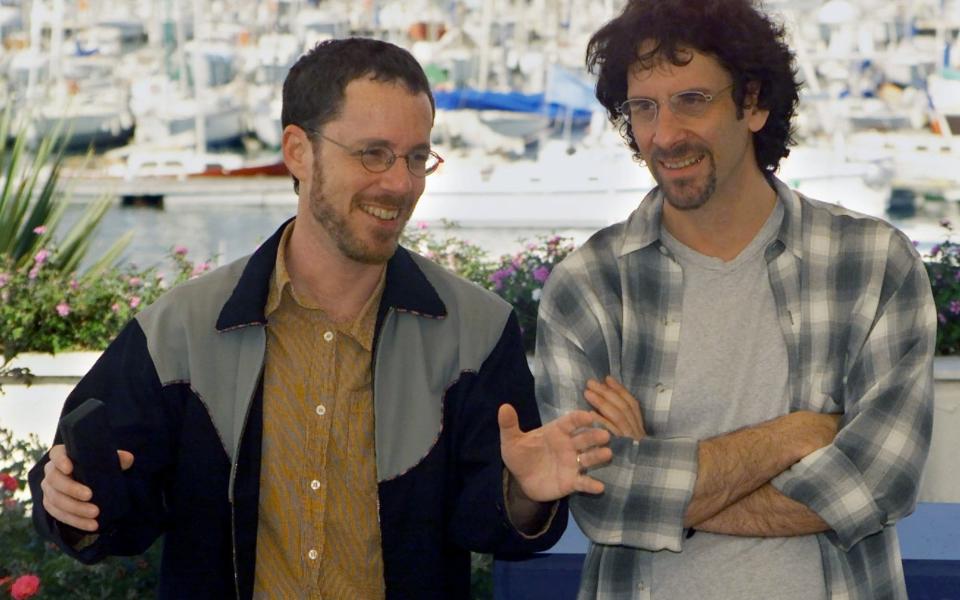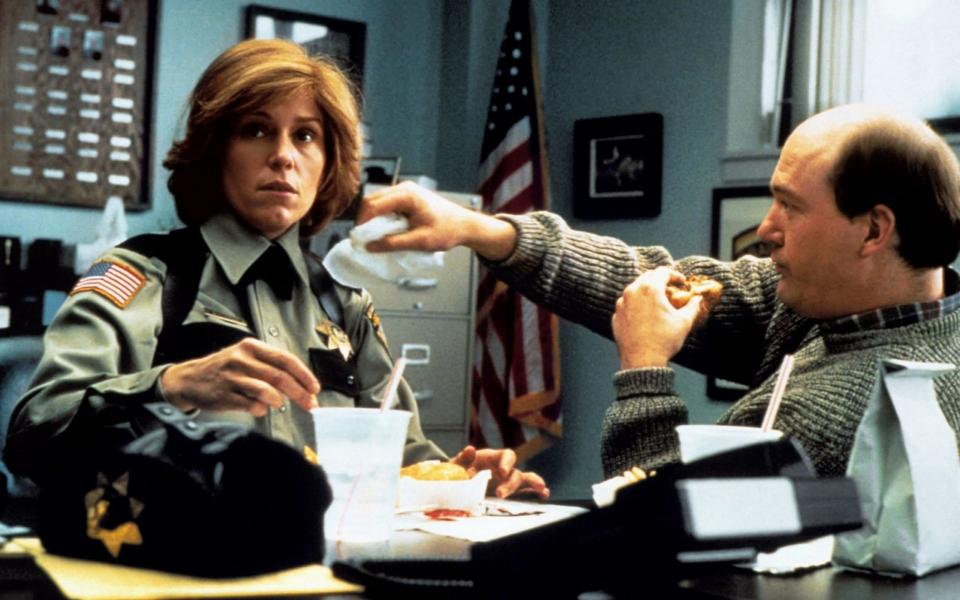Blood, blizzards, and the true(ish) story behind Fargo

It’s 25 years since Fargo – “a homespun murder story”, as it was then billed – premiered in Cannes. We think of it now as quintessential Coen Brothers, and part of the pantheon of great American crime movies. Belatedly, it spawned the spin-off TV series on FX in 2014, which has run by now to four seasons and counting.
If you asked the average filmgoer to put on a Minnesotan accent, there’s a sizeable chance they’d attempt an impression of Marge Gunderson, Frances McDormand’s pregnant cop, with her litany of “you betcha”s and “real good then”s and “oh yaah”s. Thanks to Marge and every one of its finely etched characters, Fargo is part of the cultural furniture at this point – as enshrined as any 1990s classic you could name.
In a serious way, it saved the Coen Brothers, and guaranteed a longevity they might not otherwise have had. Five films deep into their careers, they were critical darlings, but only their second film, Raising Arizona (1987), had been a notable success with the public.
The last three – Miller’s Crossing (1990), Barton Fink (1991) and The Hudsucker Proxy (1994) – had all lost money, and in the final case, a fortune, recouping a small fraction of its $25m budget. The industry was impatient for them to justify their glowing press: a certain perception of them as aloof eggheads, wise-cracking about cinema’s past, was beginning to chafe.
1994 was a particularly unfortunate time for them to strike out, just as Quentin Tarantino muscled in with Pulp Fiction – a winking, postmodern genre exercise which managed the triple feat of dazzling critics, gobbling up awards and catapulting him to the very mainstream success that kept eluding the Coens.
The outline of Fargo did not fill anyone with great hope. The brothers admitted at the time that they felt under pressure to change tack, abandoning the stylised theatrical flair and period homage of Hudsucker in favour of something more modern, more “reality-based”, and on a much lower ($7m) budget.
Even so, the bleakness and amorality of their story, with bodies piling up in the snow of their chilly home state, made associates panic. “Do not make Fargo!” advised their friend William Preston Robertson, later the author of a book about the making of The Big Lebowski. “It’s the weirdest, most bizarre, most inaccessible of all of the things you’ve written.”
For one thing: it wasn’t set in Fargo, North Dakota, but instead in Brainerd, Minnesota (the script’s original title was, in fact, Brainerd). And no one could quite tell if it was based on a true story or not. “This is a true story,” announced the opening captions, declaring that the film’s events took place in Minnesota in 1987. “At the request of the survivors, the names have been changed. Out of respect for the dead, the rest has been told exactly as it occurred.”
This was patently untrue. The Coens would soon become notorious for laying these kind of false trails. Their long-standing editor, Roderick Jaynes, turned out to be an alias for the brothers themselves. Their Depression-era comedy O Brother, Where Art Thou? (2000) announced itself in the credits to be an adaptation of Homer’s Odyssey, which the brothers later admitted they’ve never read.

In Fargo’s case, there are bits and pieces that are vaguely truth-derived, cobbled together from at least two separate crime stories the Coens once heard about from someone, somewhere, as Joel told HuffPost in 2016. “One of them is the fact that there was a guy, I believe in the ’60s or ’70s, who was gumming up serial numbers for cars and defrauding the General Motors Finance Corporation. There was no kidnapping. There was no murder.”
The other thing did, at least, involve a method of body disposal that would inspire the film’s grisly denouement, albeit with culprit and corpse reshuffled wholesale in Fargo’s script. “There was a murder in Connecticut,” Joel confirmed, “where a man killed his wife and disposed of the body – put her into a wood chipper. But beyond that, the story is made up.”
This woman was Helle Crafts, a Danish flight attendant who disappeared in 1986, leading to the investigation of her husband, Richard Crafts, for her murder. Despite the absence of a cadaver, he was convicted in 1989, after forensic evidence proved the hypothesis that he had, indeed, chipped her into oblivion.

How did this become the starkly horrifying scene where Marge creeps up on stone-faced Gaear (Peter Stormare) feeding the last portions of his chatterbox accomplice Carl (Steve Buscemi) into one of those machines? That would be down to the Coens’ absolute indifference to the details of any true crime yarn you could pick out. All they wanted was the essence of it feeling true.
The husband in their tale, Jerry Lundegaard (a squirmy, career-best, Oscar-nominated William H. Macy), is a desperate car salesman whose number is up, and who therefore arranges for Gaear and Carl to kidnap his wife Jean (Kristin Rudrüd, who we never see again), planning to extort her father (Harve Presnell) for a cool $1m.
Needless to say, nothing about Jerry’s plan goes swimmingly, thanks to the greedy ineptitude of all involved. The plot is more or less total fiction, but that’s not to say the brothers didn’t lead their cast on a merry dance. William H. Macy wanted to know all the non-existent facts about the “real” Jerry, assuming the Coens wouldn’t be so shameless as to lie to their audience outright.

Over the years, the pair have gone back and forth teasingly on how much of this “true crime” set-up was pure bluff. In fact, they were fairly honest right from the start. In a 1996 interview with Positif, Joel Coen came clean about the logic behind Fargo’s pseudo-verité stylings. “We were not interested in making a documentary [...] and we did no research about the nature of the murders or the events connected to them. But in warning viewers that we had found our inspiration from a real story, we were preparing them to not view the film like an ordinary thriller.”
It was a classic, if devious, way for the Coens to shake off their air of being intellectual fantasists and get real for the first time – or at least make a show of doing so.
Fittingly, the film’s photographic style was much less splashy than anything they’d tried out before. They had Roger Deakins as their cinematographer for the third time, but restricted the camera’s movement as much as possible, wanting a preponderance of long shots outdoors, with snowy flatlands extending into a near-horizonless distance, and no other landscape features of any kind.
As bad luck would have it, this caused them problems on the shoot, because the area around Minneapolis was unseasonably mild that winter, requiring artificial snow to be trucked in. The opening shot of a car being towed in white-out, as the credits unfurl and Carter Burwell’s majestic score pipes up, was captured by Deakins’s assistant, Robin Brown, while everyone else was shooting on the 16th floor of an office building. They became aware that a much-needed blizzard was rolling in, and had the sequence plotted out just in case.
“It’s Siberia, but with family restaurants.” That’s how the Coens describe their birth state, which goes some way to conveying Fargo’s folksy local flavour and the effortful niceness of almost every incidental character. As a heroine, Marge is slow to arrive – more than a half-hour has elapsed before she does – and it’s then that the film’s crucial balancing of tones makes itself clear. There’s a version of Fargo that’s imaginable without her, but what a coldly mathematical demonstration of human folly that might be – a black-hearted exercise of which the Coens are certainly well capable.

It’s Marge, with her persistent good humour and squawking unflappability; her occasional sharp umbrage and instinct for sniffing out lies; her precious cargo under that police coat; her pesky morning sickness, who is the film’s beacon of everyday goodness amid so much twisted chicanery.
As played sublimely by McDormand, who had been married to Joel for over a decade, she’s the character who enabled audiences to feel they were getting to know the Coens a little more deeply here. It’s thanks to her that we’re invited to get past the veneer of misanthropy erected, not just in that first half-hour, but across the brilliant stylings of their past work.
Even the name of Marge’s cheerfully bovine husband, Norm (John Carroll Lynch) suggests a bedrock of American decency, especially when she calls him “Normie”. (It seems quite plausible that the Coens had Norman Rockwell in mind.) Ironically, their schlubbily content relationship is the most believable aspect of the whole film, even though neither person has anything to do with the story’s spurious true crime origins. They are lovingly rendered, straight from the heart.

It was appropriate that McDormand won the first of her three Best Actress Oscars here, for being nothing less than the film’s conscience and the filmmakers’ salvation. She gave their oeuvre the most credible human face it has presented then or since – with honourable mentions to Jeff Bridges in The Big Lebowski and Oscar Isaac in Inside Llewyn Davis.
In that year of independent film taking the Oscars by storm, with Secrets and Lies and Shine giving The English Patient a run for its money, Fargo managed seven nominations overall, winning for McDormand and for the Coens’ original screenplay. It was no megahit, exactly: on US release in March 1996 it took a decent $24m, which became a worldwide $60m once awards had rolled around.
Then again, the box office heights of a Tarantino have never been anywhere near the Coens’ grasp, and I’m not sure we’d want them trying. We need them to stay weird and embrace the weirdness of their people, while sometimes curbing their predilections for smug flash or overriding cynicism. That’s exactly what they did in Fargo, and that’s why it’s so great.

